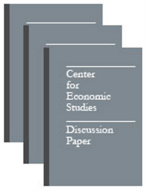Gross Job Creation, Gross Job Destruction and Employment Reallocation
Gross Job Creation, Gross Job Destruction and Employment Reallocation
Abstract
This paper measures the heterogeneity of establishment-level employment changes in the U.S. manufacturing sector over the 1972 to 1986 period. Our empirical work exploits a rich data set with approximately 860,000 annual observations on 160,000 manufacturing establishments to calculate rates of gross job creation, gross job destruction, and their sum, gross job reallocation. The central empirical findings are as follows: (1) Based on March-to-March establishment-level employment changes, gross job reallocation averages more than 20% of employment per year. (2) For the manufacturing sector as a whole, March-to-March gross job reallocation varies over time from 17% to 23% of employment per year. (3) Time variation in gross job reallocation is countercyclic-gross job reallocation rates covary negatively with own-sector and manufacturing net employment growth rates. (4) Virtually all of the time variation in gross job reallocation is accounted for by idiosyncratic effects on the establishment growth rate density. Changes in the shape and location of the growth rate density due to aggregate-year effects and sector-year effects cannot explain the observed variation in gross job reallocation. (5) The part of gross job reallocation attributable to idiosyncratic effects fluctuates countercyclically. Combining (3) – (5), we conclude that the intensity of shifts in the pattern of employment opportunities across establishments exhibits significant countercyclic variation. In preparing the data for this study, we have greatly benefited from the assistance of Robert Bechtold, Timothy Dunne, Cyr Linonis, James Monahan, Al Nucci and other Census Bureau employees at the Center for Economic Studies. We have also benefited from helpful comments by Katherine Abraham, Martin Baily, Fischer Black, Timothy Dunne, David Lilien, Robert McGuckin, Kevin M. Murphy, Larrty Katz, John Wallis, workshop participants at the University of Maryland, the Resource Mobility Session of the Econometric society (Winter 1988 meetings), an NBER conference on Alternative Explanations of Employment Fluctuations, and the NBER’s Economic Fluctuations Program Meeting (Summer 1989). Scott Schuh provided excellent research assistance. We gratefully acknowledge the financial assistance of the National Science Foundation (SES-8721031 and SES-8720931), the Hoover Institution, and the Office of Graduate Studies and Research at the University of Maryland. Davis also thanks the National Science Foundation for it’s support through a grant to the National Fellows Program at the Hoover Institution. Most of the research for this paper was conducted while Davis was a National Fellow at the Hoover Institution.




